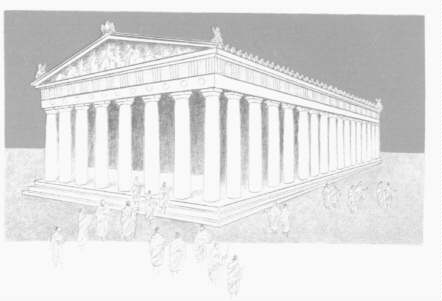
The second half of the 5th century B.C. was the Golden Age of Greece. This was the period of her most beautiful art and architecture, and some of her wisest thinkers besides. Both owed much to the popular new study of geometry.
By the start of the next century, geometry itself was entering its own classic age with a series of great developments, including the Golden Mean. The times were glorious in many ways. The Persian invaders had been driven out of Hellas forever, and Pericles was rebuilding Athens into the most beautiful city in the world. At his invitation, Greek mathematicians from elsewhere flocked into the new capital. From Ionia came Anaxa- goras, nicknamed "the mind." From southern Italy and Sicily came learned Pythagoreans and the noted Zeno of Elea. And their influence was felt over all Athens.
High on the hill of the Acropolis rose new marble temples and bronze and painted statues. Crowds thronged the vast new open-air theater nearby, to hear immortal tragedies and comedies by the greatest Greek playwrights. These splendid public works were completed under the direction of the sculptor Phidias and several architects, all of whom knew and used the principles of geometry and optics. "Success in art," they insisted, "is achieved by meticulous accuracy in a multitude of mathematical proportions." And their buildings had a dazzling perfection never seen before-the beauty of calculated geometric harmony.
Their method was borrowed from the geometers. They called it dialectics, and it was patterned after the deductive reasoning and proofs of geometry. "For geometry," they said, "will lead the soul toward truth and create the spirit of philosophy."
And geometry itself made tremendous strides in the Golden Age and the darker time that followed. Even after Athenian democracy collapsed in the war with Sparta, geometry continued to flourish in the Athens of the restored aristocracy.
But now, in the 4th century, the study was carried on in schools with grounds and buildings of their own. The first and most famous of these was the Academy, headed by the great philosopher Plato. It was located in an olive grove a half-mile outside of town, and over ifs gate was this inscription:
Plato's Academy was the earliest institution of higher learning. Its curriculum was frankly inspired by the old program of the Secret Brotherhood. Studies were broader now- the highest branch was moral and political philosophy. But the ideal was still pure wisdom, and the basic training was still in the "Mathemata." Plato was partly a Pythagorean.
When his teacher, Socrates, was put to death by the Athenian government, Plato had fled to Sicily. There he studied mathematics under noted Pythagoreans, picked up mystical ideas, and
Perhaps the most gifted geometer to study there was Eudoxus of Cnidus, who finally broke the deadlock of the irrationals, and freed geometry for the great advances that were to come. How he did this-with his work on the Golden Mean and his new theory of proportion-is an exciting story. And if we add a bit of imagination, it gives us a fascinating glimpse of Athens and the Academy in Plato's time.
At the age of twenty-four, Exodus came to Athens from his home town of Cnidus on the Black Sea, in order to study at Plato's Academy. He was so poor that he could not afford lodgings in the city, but lived in the small seaport of Piraeus and walked to school every day. Of course, he had already studied some geometry; it was the entrance requirement. But at the Academy he got particularly interested in the matter of an irrational number of a geometric figure. For in Athens the problem was in plain sight every day, in a concrete, or rather, a marble form.
On the high Acropolis, against the shimmering sky, stood the beautiful temple called the Parthenon-the most wonderful monument of the Age of Pericles, the "perfect" building whose ruins enthrall us even today. The Parthenon had been designed by Ictinus and Callicrates according to mathematical principles Its surrounding pillars were an example of "number" applied: 8 pillars in front, an even number, as Pythagoras had advised, so no central posts would block the view; but 17 pillars on each side, where it was all right to have an odd number. And some of

its lines were deliberately curved and slanted to correct optical distortions.
But above all, the Parthenon was a crowning example of proportion in architecture. Scholars still marvel at the logical and harmonious ratios in the whole building and its various parts. And this beauty was achieved with one of the "dynamic rectangles" then in vogue.
Like many Greek temples of time, the Parthenon used the "root five rectangle," a rectangle with an irrational side the square root of 5. How did this root five rectangle come to be used? How was it constructed and shown to be irrational? How did Eudoxus analyze in it the most beautiful of all linear proportions, the Golden Section, or Golden Mean? That is our story.
The development was natural in the architecture of the Golden Age. Greek builders, we must remember, did not have a minutely
But as geometry became popular in Athens, architects took to drawing careful plans with string and straightedge, for geometric constructions could be enlarged easily and accurately in the building itself.
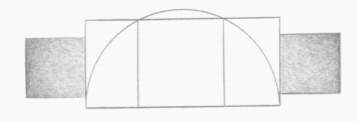
Temples remained severely rectangular, but now the favorite rectangle was made by a "construction": a square inscribed in a semicircle. This figure gave you the shape of the rectangle: it was as long as the semicircle's diameter, as high as the inscribed square. Calculating its numerical dimensions was easy with the Pythagorean theorem; any builder or Academy student knew how in those days. The rectangle had an irrational dimension. When its width was 1, its length was the square root of 5.
This "root five rectangle" was enough to discourage any member of the Secret Brotherhood-but Eudoxus belonged to a new age. After studying for a while at the Academy, he went to Egypt, where he studied under the learned priests. Afterward, he traveled and established his own school. Then, years later, he returned to Athens to revisit his former master Plato.
Eudoxus chose his words with care. He had promised to tell Plato a great discovery at dinner, and it would be based on this novel demonstration.
"I will ask you," he said, "to disregard numbers entirely, and forget all about the numerical dimensions of the 'root five rectangle.' We will try instead to find a proportion among the geometric quantities. So now, look at the construction itself, the square inscribed in the semicircle." Using string and straightedge, Eudoxus drew it on the sand.
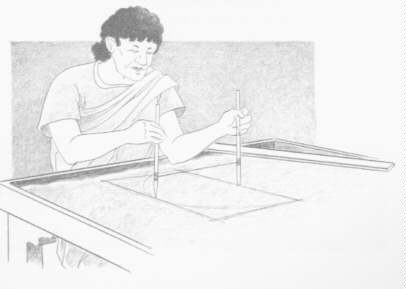
"Look at the straight lines in the whole construction. You will see that there are only two geometric quantities throughout. What are these? One is b, the width of the square, wherever it occurs. Now study the diameter of the semicircle. On that line there are three segments. The long segment is simply b, the base of the square. The two short segments, a and a, on either side, are equal-for each equals the radius minus 1/2 the base of the square.
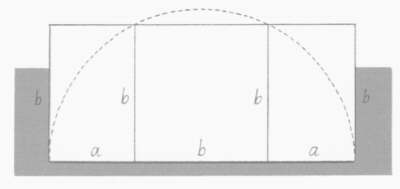
"Reduced to its simplest terms, therefore, the problem is to find a proportion between the geometric quantities a and b, irrespective of any numerical dimensions. So here is the figure once more, simplified to show the problem in this simplest form.
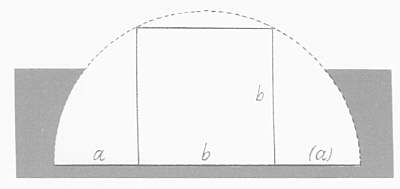
Consider only the line

that is, only that portion of the diameter, where our two quantities a and b can be defined as a short and a long segment of one line.
"Now here is my question: What is the proportion that links a and b, the short and long segments of this line? Does anybody see how to find out?"
A ripple of excitement rose from the students gathered in the grove of the Academy, as they peered at the diagram and discussed this "simple" problem in whispers. Plato himself stood by, smiling. Finally, when no one volunteered, Eudoxus raised his hand for attention and continued.
"Nothing could be simpler than the answer. It involves a very easy construction that you all know already. From the upper right corner of the square, I will just draw two lines to the ends of the diameter. What does that give you?" He pointed to an eager student in the front row.
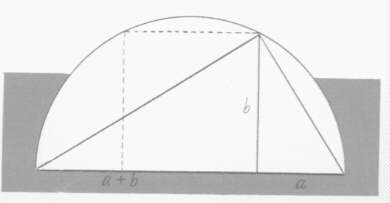
"A right triangle, of course," the boy almost shouted. "Lines drawn from any point on the circumference to the ends of the diameter make a right angle!"
"What else do you see?"
Several students answered at once: "Inside this large right triangle are two other right triangles! They are formed by a side of the square-but it is now a perpendicular line dropped from the vertex of the large right triangle to its hypotenuse."
"Absolutely right!" said Eudoxus, pointing them out. "We will call one S for Small, and the other M for Medium; and the large right triangle, of course, can be L for Large. Now, do you see any relationship between these three right triangles?"
There was a pause, while all the students stared intently at the diagram. Suddenly a boy called out from the back row, "The three right triangles are similar, aren't they?"
"How do you prove that?" Eudoxus was nodding his approval.
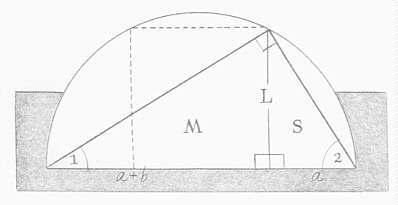
"Sir, they are similar because their angles are equal. If you will kindly spin the three right triangles around and draw them side by side and upright, then everyone else can see the proof."
Eudoxus gladly obliged, and, using his pointer, he explained for the benefit of the slower students, "Notice on the figure that each of the smaller triangles has an angle in common with the large triangle. But we know that in any right triangle the sum
of the other two angles is 90*. So each of the remaining angles must be equal respectively. The three right triangles are therefore similar, just as-what is your name, lad?-just as Meno here has said, because their angles are equal. Meno has solved the problem!"
"But sir," protested Meno in amazement, "of what use is it for us to know that the right triangles are similar?"
"Of what use?" repeated Eudoxus, laughing. "Look again, all of you, and you will see the beautiful proportion that links the geometric quantities a and b." He pointed in quick succession to all the drawings on the sand.
"Just take the dimensions from the final figure, and put them on the easy-to-see similar right triangles, just the Small and Medium ones. You know that when right triangles are similar, their corresponding sides are in proportion. Therefore,
Short Side of Small Triangle is to Long Side of Small Triangle as
Short Side of Medium Triangle is to Long Side of Medium Triangle or in other words: a is to b as b is to a + b
"That is your proportion! Just read it off on the line, and you will see how beautiful it is:
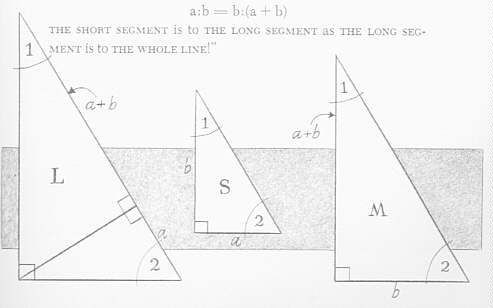
"High-rete! High-rete! High-rete!" cried all the students in unison-the Greek equivalent of three cheers.
Plato himself joined the chorus of praise and made a short speech: "You have just seen a beautiful demonstration and proof-one of the most ingenious in geometry. This proportion is far more significant than the problem that led to it. So I will ask you all to review the construction for your next assignment.
"By inscribing a square in a semicircle, you can do something truly marvelous with a straight line. You can divide that line into two unequal sections, in such a way that the short section is to the long section as the long section is to the whole line. Do you appreciate this proportion? You are thus dividing a line geometrically into its extreme and mean proportional. This section, or cutting, of a line is so important that from now on we will call it THE SECTION." Plato drew and wrote on the sand.
Plato gave a banquet in Eudoxus' honor that night-history records the event-and heard the rest of the discovery from Eudoxus' own lips. Before we join them at dinner, let us pause (like the boys at the Academy) to appreciate the importance of "The Section." Plato himself, in his writings, always called it that. But later writers named it the Golden Section or the Golden Mean.
The lasting fame of the Golden Mean rests not only on the sheer beauty of the proportion itself, but on its use in architecture and art. The "root five" and Golden Section rectangles were used frequently in Greek buildings. Scholars have since found that many of the loveliest classical vases and statues cherished today, on the hills of Greece and in museums throughout the world, are based on this same section. And sculptors and painters down the ages have continued to make use of it.
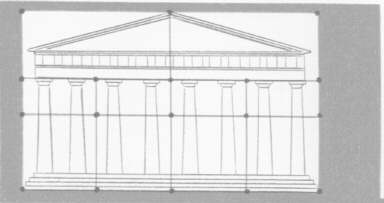
The facade of the Parthenon apparently was designed around the proportions of two large and four small Golden Section, or *5, rectangles, placed above four squares.
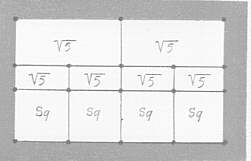
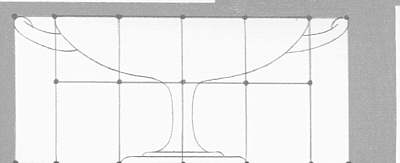
This Creek vase, known as a kylix, was designed to be contained within a Golden Section. The bowl of the vase follows the proportions of four squares placed together horizontally.
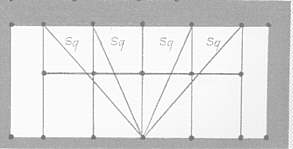
The Golden Mean is a surprising clue to the proportions of the human body. Just look at the different lengths in your own hand and fingers and forearm, and you can see this yourself. The length of tile first finger joint is to the length of the next two joints as those two are to the length of the whole finger! The length of the middle finger is to the length of the palm as the length of the palm is to the length of the whole hand! The length of the hand is to the length of the forearm as the length of the forearm is to the whole length from fingertip to elbow.

Experts have made many more measurements, and have found that this proportion runs through the whole human skeleton-not exactly, of course, but as a kind of "ideal" proportion or standard of beauty. That is why the Golden Mean has fascinated some of the greatest artists through the centuries. Leonardo da Vinci, for instance, called it the "Divine Section."
The Section was actually the key to the geometric construction of the pentagon and of the fifth regular solid, the dodecahedron, with its twelve pentagonal faces-not their mere freehand drawing or building up with tiles as before, but their perfect construction with string and straightedge. These and other beautiful shapes can be drawn easily if you just use the Golden Section.

Taking the line AB as radius and using A and C as centers, draw arcs intersecting at D. Using AC as radius, draw arcs that cut the long arcs at E and F. Then AC, CF, FD, DE, EA form a pentagon. A five-pointed star can be formed by drawing AF, EC, DA, amid DC.
Of course, this conversation is imaginary, but Eudoxus of Cnidus actually was the greatest mathematician of his age, and the Golden Section theorems were his most striking achievement.
Another great geometer, an Athenian friend of his and Plato's, named Theaetetus, probably worked on the theorems first, and Plato himself doubtless taught the subject at the Academy. But it was Eudoxus who finally broke the tyranny of number, with his magnificent new theory of proportion, so we have made him the hero of our story. He really must have contemplated the Parthenon in his student days. And we used "poetic license" to let him demonstrate The Section in the olive grove on the real occasion of his return visit to Athens. That way, you could see for yourself The Section's brilliant role in the Golden Age of Greece -and how, at Plato's Academy, Eudoxus and others freed geometry for the still more brilliant developments to come.